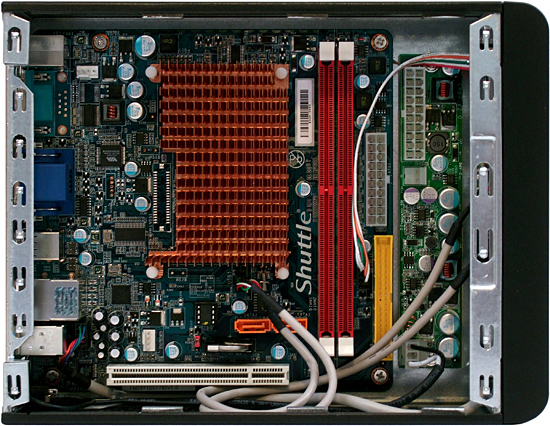Shuttle XS29F: Is VIA's Nano Processor Powerful Enough?
VIA Nano In Action: Shuttle XS29F
A textured finish and black band across the face visually separate the XS29F from the X27D, but ports remain identical. Shuttle provides separate VGA and DVI-D connections, rather than using a DVI-I connector with an adapter. This could be a concern when buying a replacement monitor cable, since a few have extra pins surrounding the flat connector in the DVI output. The lack of any HDMI connector or adapter is an indication of XS29F and X27D desktop positioning.
The XS29F is a little more interesting internally, as the size of its passive sink is reminiscent of Pentium MMX days, and the motherboard is not a Shuttle form factor (two slot) design. The actual form factor for both the XS29F and its Atom-based sibling is Mini-ITX (one-slot), a standard developed by VIA for previous-generation compact systems. The resulting style is more book-sized rather than cubical.
Not that the single PCI slot is accessible, unfortunately. In fact, we wouldn’t be surprised if Shuttle removed it from production version, since the case doesn’t support expansion.
A moderate 1MB L2 cache and relatively simple design by modern x86 CPU standards lends itself to a small 63mm² die and low 5W TDP, in spite of the U1700 processor’s "ancient" 65nm process technology. Packing the contacts into VIA's NanoBGA2 format further decreases package size to 21x21mm, freeing up a substantial amount of motherboard real estate.
The VX800 single-component chipset appears much larger than the CPU, its S3 Chrome9 H3 graphics and Vinyl HD Audio controllers accounting for at least part of that increase. Interfacing the CPU, two channels of memory, and several peripheral interfaces, its ball grid grows to 31x31mm.
Get Tom's Hardware's best news and in-depth reviews, straight to your inbox.
Current page: VIA Nano In Action: Shuttle XS29F
Prev Page Neo Nano Next Page Intel Atom In Action: Shuttle X27D-
Wouldn't this just be a linux-only machine then? I can't possibly see any other use for it other than maybe a childs pc or a general "Internet & Email only" PC.Reply
-
pakardbell486dx2 This may be a dumb question, but why was Xp not used for this test? Clearly "just barely" wont work for people who spend their hard earn money on something like this. Maybe the celeron is ok for vista basic but the atom and nano platforms are just not good enough for Vista. If I can make an analogy comparing Vista and Atom/Nano it's like an old 73' Corolla trying to haul ten tons uphill.Reply -
tacoslave amd huron platform thats all i have to say i want to see it benched see how it stakes up.Reply -
Blueridge I agree that the major drawback of this review is the use of Microsoft Vista. I think that Windows XP Home edition for ULPC or a netbook spin of a linux distro (e.g. Ubuntu) would have been a much better choice for this review, especialy since is very well known that Vista is just not the right choice for netbooks (or nettops). Some time ago I read several reviews of the nano processor, based on Win XP and they performed more than OK, they were even suitable for a small HTPC at that time (the toughest challenge was DVD playback back then) and with a better chipset would have performed even netter. But this happens when a resource hungry OS like vista is used... just my 2 cents.Reply -
HalfHuman i guess a windoze xp or 7 would be a lot better to use with this kind of hardware. in fact i cannot think at a more inapropriate os to run on a nentop than vista. :)Reply
maybe the performance delta would be the same but the usability would be more than "acceptable".
regarding the "benchmarking" stuff... i do not think that anybody sane would buy a nettop to use it for hardcore photo editiing or transcoding.
if i'd buy a nettop i'd be interested in several factors:
- to be powerfull enough for office work and maybe hd playback
- to use as little power as possible (which nano does nicely) as this kind of device would be rarely powered down
- to be silent (which nano is)
i think that performance per watt is irrelevant here as a system like this is not meant to be "performant". i think that the one that uses less watts, has more features is queter wins here.
my take on this is that via has a very nice platform and nano wins even if it's not the fastest. -
Blueridge I just took a look at Via's website and it seems that Nano is available in flavors up to 1.8GHz. I wish a machine based on such a processor was used for this review, though I think the main issue here is availability.Reply -
HalfHuman i would be nice to see some noise evaluations, some hd playback tests... some appropriate os. :)Reply -
eddieroolz The Nano would be the perfect computer to just leave it powered on, seeding torrents and such.Reply




